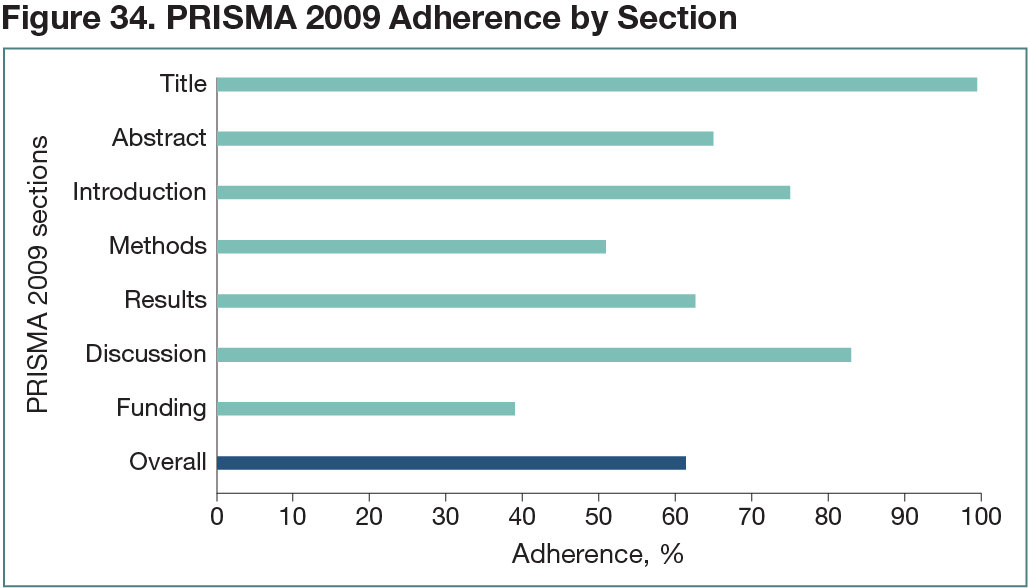Abstract
Completeness of Reporting and Its Association With Risk of Bias in Systematic Reviews Published in Rehabilitation Journals: A Meta-research Study
Tiziano Innocenti,1,2 Daniel Feller,3 Silvia Giagio,4,5 Stefano Salvioli,2,6 Silvia Minnucci,7 Fabrizio Brindisino,7,8 Carola Cosentino,6 Leonardo Piano,9 Alessandro Chiarotto,1,10 Raymond Ostelo1,11
Objective
Problems with reporting a scientific study can affect research in different manners. For example, it is known that study methods are frequently not described in adequate detail and that results are presented ambiguously, incompletely, or selectively. A previous study1 confirmed that most of the authors (approximately 67%) publishing systematic reviews (SRs) in high-impact rehabilitation journals did not mention the use of a reporting guideline. Therefore, the objectives of this study were (1) to evaluate the completeness of reporting of SRs published in rehabilitation journals by evaluating their adherence to the Preferred Reporting Items for Systematic Reviews and Meta-Analyses (PRISMA) 2009 checklist, (2) to investigate the relationship between completeness of reporting and risk of bias (ROB), and (3) to study the association between completeness of reporting and the characteristics of SRs and journals.
Design
A random sample of 200 SRs published between 2011 and 2020 in the 68 rehabilitation journals was indexed under the rehabilitation category in the InCites Journal Citation Report. Two independent reviewers evaluated the completeness of reporting as the adherence to the PRISMA 2009 checklist and assessed ROB using the ROBIS tool. Overall adherence and adherence to each PRISMA 2009 item and section were calculated as a percentage of the total number of items described and reported of the total number of applicable items. Regression analyses investigating the association between completeness of reporting, ROB, and other characteristics (impact factor, publication options, year of publication, and study protocol registration) were performed.
Results
The mean overall PRISMA 2009 adherence was 61.4% (Figure 34). Studies with high ROB in ROBIS domain 1 had an overall adherence to the PRISMA 2009 checklist, which was 5.70% (95% CI, −10.07% to −1.34%) lower than those with low ROB. In domain 2, studies with high ROB had 5.41% (95% CI, −9.74% to −1.07%) lower adherence than those with low ROB. Studies with high overall ROB had 7.06% (95% CI, −12.10% to −2.01%) lower adherence than those with low overall ROB. Studies published in fourth-quartile journals displayed an overall adherence of 7.24% (95% CI, −13.19% to −1.29%) lower than those published in the first quartile; there was an 11.95% (95% CI, 5.94%-17.96%) increase in overall adherence if the SR protocol was registered.
Conclusions
The completeness of reporting in SRs published in rehabilitation journals is still suboptimal. High ROB is associated with poorer completeness of reporting, indicating that if a study has better reporting, this could positively affect the transparency of the ROB evaluation. The registration of study protocols and journal ranking are also associated with a more complete reporting. Authors of SRs should improve adherence to the reporting standards, and journal editors could implement strategies to optimize the completeness of reporting.
Reference
1. Innocenti T, Salvioli S, Giagio S, Feller D, Cartabellotta N, Chiarotto A. Declaration of use and appropriate use of reporting guidelines in high-impact rehabilitation journals is limited: a meta-research study. J Clin Epidemiol. 2021;131:43-50. doi:10.1016/j.jclinepi.2020.11.010
1Department of Health Sciences, Faculty of Science, Vrije Universiteit Amsterdam, Amsterdam Movement Sciences, Amsterdam, the Netherlands, t.innocenti@vu.nl; 2GIMBE Foundation, Bologna, Italy; 3Provincial Agency for Health of the Autonomous Province of Trento, Trento, Italy; 4Division of Occupational Medicine, IRCCS Azienda Ospedaliero-Universitaria di Bologna, Bologna, Italy; 5Department of Biomedical and Neuromotor Sciences (DIBINEM), Alma Mater Studiorum, University of Bologna, Bologna, Italy; 6Department of Neuroscience, Rehabilitation, Ophthalmology, Genetics, Maternal and Child Health, University of Genoa, Genoa, Italy; 7Department of Clinical Science and Translational Medicine, University of Rome Tor Vergata, Rome, Italy; 8Department of Medicine and Health Science “Vincenzo Tiberio,” University of Molise, Campobasso, Italy; 9Unit of Rehabilitation and Functional Recovery, Fondazione dei Santi Lorenzo e Teobaldo, Rodello, Italy; 10Department of General Practice, Erasmus MC, University Medical Center, Rotterdam, the Netherlands; 11Department of Epidemiology and Data Science, Amsterdam UMC, Location VUmc, Amsterdam Movement Sciences Research Institute, Amsterdam, the Netherlands
Conflict of Interest Disclosures
None reported.

